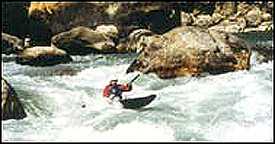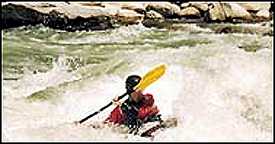India’s Rafting
Adventures Reach New Heights
November, 2002 Marks First Commercial Brahmaputra Descent
India is rarely considered an extreme sports destination. On the international market it is touted as an exotic cultural destination. The Taj Mahal, royal Rajasthan, Goa�s golden beaches, Kerala’s backwaters, and spiritual Varanasi are often dished out with overdone zeal. If you are an adrenalin addict, sadly, India has had little to offer…until now.
India’s poor high-end adventure reputation is about to be changed. This year an experienced crew of rafters and kayakers have put together a rafting expedition down the mighty Brahmaputra. It’s a big project by any standard, aimed at putting India on the international white water map and to commemorate the International Year of Eco-Tourism. The November 2002 descent of a 180-km stretch of the Brahmaputra will mark the first non-military expedition on the river and the first commercial foray in the politically sensitive region. "This section is normally off limits to foreigners, due to its proximity to China," says expedition leader Vaibhav Kala of Aquaterra Adventures. "It’s been run a few times by the armed forces, but it’s never been properly documented. Now, thanks to a special permit, it will finally be open to other adventurers and given the recognition it deserves." Aquaterra plans the 2002 trip as the first of an ongoing series of commercial adventure white water tours on this section of the river.
|
"This expedition takes up where Lindgren left off," says Paddler Magazine Publisher and Editor-in-Chief Eugene Buchanan, referring to kayaker Scott Lindgren’s well-documented 2002 expedition run of the upper Tsangpo. "With the information gleaned from this lower section, we will finally have a picture of the entirety of the ‘Everest of Rivers.’"
The Brahmaputra enters India in the far eastern state of Arunachal Pradesh after traveling hundreds of miles across Tibet as the Tsangpo from its birthplace near the holy lake of Mansarovar. The Tsangpo is at its worst just before it enters India at Gelling. An incredible flow of 2 million cubic feet per second slices through a fabled gorge section called the "Big Bend," dropping about 150 ft per mile. At the border, the fury of the Tsangpo, descending from the eastern Himalayas, is controlled but no less potent. This formidable force is now called the Siang and it forms the stage for an expedition called the Great Brahmaputra Descent. From the put-in just below the Tsangpo’s famed Big Bend, the expedition will navigate 180 kilometers of Class IV-V, Himalayan-lined whitewater to the take-out eight days later at Pasighat.
The expedition group departs from Dibrugarh on November 22, 2002 and will travel for three arduous days, employing river ferries and off-road vehicles through the Arunachal rain forests to reach the remote village of Tuting. This is wild country inhabited by the Adi Tribals who still live a life in harmony with nature, happy and content with what the forest provides. Theirs is a community governed by a strong Kebong village council and the social fabric of the coexisting clans. In the true spirit of eco-tourism, the expedition group will have a first-hand experience of this lifestyle through close village interaction. But the cultural experience is just a kick-start to the awesome journey ahead.
|
Over an eight-day period the group in three rafts and several kayaks will tackle the
roaring whitewater in their attempt to descend the Siang section of the upper Brahmaputra.
It has been rafted a few times by joint armed forces trips for tactical reasons, but this
will mark the first commercial departure. If all goes as planned, further runs of the
river are in the offing for Aquaterra’s 2003 adventure rafting schedule. India has
finally arrived as an adventure destination!
In fact, there is so much hype internationally that "Paddler," the world�s
foremost whitewater journal has signed on as an event co-sponsor and will be covering the
descent. A number of leading expedition kayakers are joining this first trip on the
amazing Brahmaputra, and additional sponsorship opportunities are available. A few spots
on this first expedition are still available for a round trip cost of $3,000 to
adventureous customers. The price for the trip, Nov. 22 - Dec. 6, 2002, includes roundtrip
airfare from New Delhi to Dibrugarh, lodging in Delhi and Dibrugarh, restricted area
permit fee, royalty for rafting the Siang, road travel, tented and rest house/hotel
accommodation, all meals, guide fees, and transfers.
 |
 |
The Siang is big in whitewater terms, but the isolation of the location places the expedition far above anything else available internationally. A very sensitive border with Chinese-occupied Tibet has resulted in a strong military presence and stringent visitor permits have discouraged tourists from the region. The very chance to visit the Siang valley makes for an opportunity of a lifetime. The wilderness and cultural experience thrown in with the high-end river descent make the trip a must for anyone who wishes to break out at the top!
| Expedition Info: India’s Aquaterra Adventures
operates river and mountain trips Reprinted Press Release, August 2002 |
|